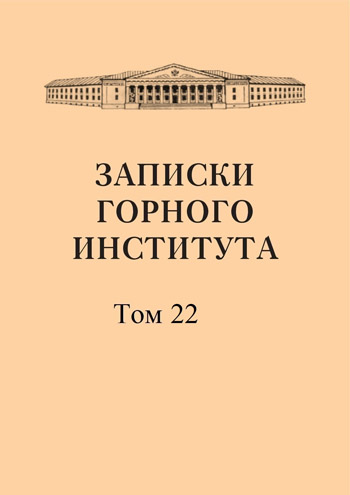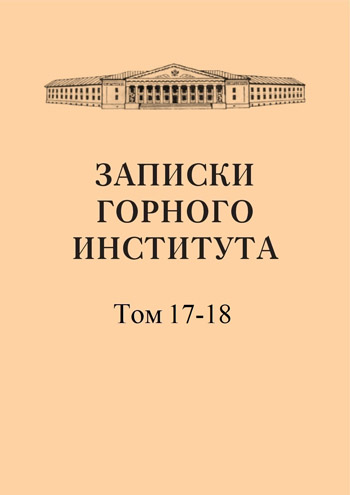-
Date submitted1947-07-19
-
Date accepted1947-09-22
-
Date published1948-08-06
A. A. Borisyak - founder of modern historical geology
- Authors:
- D. N. Nalivkin
A. A. Borisyak all his life was an active fighter for the doctrine of continuous development, the evolution of not only the organic world, but also the inorganic. For him, the earth's crust, with all the infinitely diverse phenomena associated with it, lived, changed and developed, as it lives , the countless world of animals and plants that inhabited and inhabits it changes and develops. A. A. Borisyak did extremely much for Soviet geology. He developed the doctrine of the correlative development of the earth's crust and life on it; he developed and applied the doctrine of geosynclines to the territory of the Soviet Union. Of enormous importance is the introduction into geological and paleontological work of the paleogeographical method and its most important part - the doctrine of facies. These three doctrines - the doctrine of the correlative development of earth and life, the doctrine of geosynclines and the doctrine of facies - underlie most of our work, both theoretical and practical. This is an unforgettable merit of A. A. Borisyak.
-
Date submitted1947-07-06
-
Date accepted1947-09-06
-
Date published1948-08-06
On the possibility of applying the theory of elasticity to solving problems of deformations and stresses in rocks surrounding the excavation
- Authors:
- V. D. Slesarev
The quantitative determination of the magnitude of deformations of rocks of various kinds in mine workings and the magnitude of rock pressure in the workings associated with these deformations raises the question of the fundamental possibility of applying to the solution of these problems the principles of the theory of elasticity and the theory of resistance of materials arising from the latter. It is very important to correctly solve the problem of rock pressure and rock deformation, since they essentially cover the entire complex of issues that is called rock pressure management (roof management) and which is the main and decisive factor in the correct conduct of mining operations. As a result of this circumstance, there is an urgent need to consider the possibility of applying the theory of elasticity to solving rock pressure control problems in more detail and to clarify the fundamental possibility (or impossibility) of such an application.
-
Date submitted1947-07-26
-
Date accepted1947-09-02
-
Date published1948-08-06
Седиментационный анализ при закономерной гранулометрической характеристике
- Authors:
- S. A. Andreev
Sedimentation balances are distinguished by higher sensitivity compared to other sedimentation analysis instruments, and if we discard the overly complex automation, then they are left with a simple device. However, the difficulty of proper decoding obtained by analyzing the diagram reduces these advantages. A graphical solution to the problem of determining the outputs of individual fractions by drawing tangents to the deposition curve gives figures that are only approximate and not sufficiently reliable. But if the analyzed material has a certain pattern in the distribution of grains by size, then the problem of establishing the granulometric characteristics is solved analytically, more accurately and relatively simply. Numerous studies have undoubtedly established the presence of such a pattern in the products of grinding homogeneous (monomineral) rocks."
-
Date submitted1947-07-26
-
Date accepted1947-09-10
-
Date published1948-08-06
On the movement of a heavy point along a rough helical surface with a vertical axis
- Authors:
- M. I. Akimov
Let FT and Fn be the absolute values of the tangent and normal to the surface components of the weight force acting on a point. A point placed on a surface without an initial velocity” remains in equilibrium in the presence of friction if Fr~kFN> and begins to move if Ft ⩾ kFn, where k is the friction coefficient. Differential equations of motion on a rough surface (r, φ, z) = 0 point M of weight g in cylindrical coordinates r, φ, z (z axis is directed vertically downwards) - see. article.
-
Date submitted1947-07-07
-
Date accepted1947-09-08
-
Date published1948-08-06
Observation along targets using position lines
- Authors:
- N. G. Kell
Determining ordinates (deviations from target lines) according to existing instructions is quite difficult and not accurate enough, and therefore is not always used. It is advisable to offer something more rational. The position lines of angles close to 180° or 0° are almost parallel to the sides of these angles and their gradients are equal to the arithmetic sum or difference of the gradients of the sides of these angles. This makes it easy to use such position lines when obtaining the ordinates of the alignment of benchmarks set to determine the surface displacement. These examples show the fruitfulness of the idea of using position lines. They are beginning to be introduced into practice in various areas, such as in matters of finding a lost center, transferring a project to nature, etc. It would be advisable to conduct experiments using the methods proposed here for determining displacements along alignments. It should be noted that these methods allow multiple measurements of angles and thereby increase their accuracy, whereas in other methods such an increase in accuracy is impossible without significantly complicating the measurement process.
-
Date submitted1947-07-10
-
Date accepted1947-09-03
-
Date published1948-08-06
On the issue of determining the sizes of inter-chamber pillars
- Authors:
- V. D. Slesarev
In the article “Determination of the sizes of interchamber pillars,” placed in the XVII-XVIII volume of “Notes of the Leningrad Order of Lenin Mining Institute,” an expression is given that determines the dimensions of the interchamber pillar through the adhesion force of a given rock C and its angle of internal friction. Determining the adhesion force through the tensile strength of the rock allows us to approach the issue of determining the sizes of inter-chamber pillars with great objectivity.
-
Date submitted1947-07-21
-
Date accepted1947-09-28
-
Date published1948-08-06
Fusibility diagram of the ternary system ZrO₂—MgO—AL₂O; On the problem of finding new highly refractory materials
- Authors:
- P. Ya. Saldau
- N. A. Zhirnova
The ternary system ZrO2—MgO—Al2O3 as a whole has not yet been studied. Literature data is available only on binary systems that limit the sides of this ternary system. A study of the fusibility temperatures was carried out along three sections in the ternary system ZrO2—MgO—AlO3 and it was found that in the direction from ZrO2 to the chemical compound MgO - Al2O3 there passes a continuous region of solid solutions, the melting point of which increases depending on the ZrO2 content from 2130° (spinel ) up to 2715 (ZrO2). The absence of eutectic, which causes premature softening of the material, makes these mixtures very important highly refractory.
-
Date submitted1947-07-07
-
Date accepted1947-09-28
-
Date published1948-08-06
Determination of stresses in lifting ropes for high ascent and descent heights
- Authors:
- N. P. Neronov
At higher lifting heights, both the mass and the weight of the rope must be taken into account. We will consider the latter as an elastic thread, neglecting its transverse dimensions, and limit ourselves to the case of a rope of constant cross-section. Thus, we come to some particular problem of mathematical physics.
-
Date submitted1947-07-01
-
Date accepted1947-09-27
-
Date published1948-08-06
On the issue of calculating air supply networks taking into account the performance of pneumatic tools
- Authors:
- S. S. Smorodin
In mining practice, one often has to deal with the design and operation of complex air pipeline networks. Currently, there are several technical and techno-economic methods for their calculation. For practical calculations, it is more convenient to use the nomogram located at the end of the article (see article). Using this nomogram greatly simplifies the selection of a pipeline and the calculation of all network elements. The advantage of the nomogram also lies in the fact that we can easily find from it the equilibrium states in the air duct when the pressure at the beginning of the calculation section is specified, but we do not know the mutually interconnected pressure that will be established at the receiver, the air flow rate and the pressure loss at this area. It is quite obvious that now we cannot allow a free choice of the speed of air movement in the pipe; considering the issue from the point of view of minimum economic costs, we are obliged to: find an equilibrium state in which a certain pressure at the receiver, air flow and pressure losses determined by the pressure at the beginning of the element and the diameter of the pipe will be established; This problem of finding an equilibrium state in a pipeline is solved using a nomogram through several samples.
-
Date submitted1947-07-16
-
Date accepted1947-09-20
-
Date published1948-08-06
Logarithmic-normal law of distribution of matter and its properties
- Authors:
- N. K. Razumovskii
Considering various distributions of natural qualities and properties, mainly from the field of geological sciences, the author came to the idea of replacing one argument with another, functionally related to it. With such a replacement, the type of distribution function changes and, for example, symmetrical forms of distribution turn into asymmetrical ones and vice versa . The functional transformation of variables leads to the identification of families of distribution functions that reflect the same natural process in different forms. Among the forms, there may also be simpler ones, for example symmetrical ones, and finding them is advisable. The author poses a general problem: what should be the type of connection between mutually replaceable arguments so that the asymmetric monotonic form is reduced to the Gaussian function, and in such a way that some constants remain unchanged. The solution to this problem establishes that the form of the function is logarithmic. A particular form of this connection will have the expression 2 = lg(x - a) + c. The author deduces some properties of the logarithmic distribution and points out numerous cases (in geochemistry, petrology, geology, beneficiation, calculation of mineral reserves, distribution of matter during sedimentation, hydraulic classification, etc.) where asymmetric distributions can be transformed into Gaussian form by a logarithmic transformation.
-
Date submitted1947-07-06
-
Date accepted1947-09-05
-
Date published1948-08-06
Ways to develop exploration drilling technology
- Authors:
- F. A. Shamshev
The low pace of exploration drilling and its insufficiently high quality are mainly explained by an imperfect and outdated technical base. At present, in the post-war period, extremely favorable conditions have been created for a deep reconstruction of the technical base of exploration drilling, since it is now, in full breadth, that the question arises about the need to urgently boost this industry, which was lagging behind in the pre-war period. To improve the technical base of exploration drilling, it is necessary to follow two paths: 1) along the path of small-scale mechanization and 2) along the path of creating new equipment. As a new technical base, we can outline: 1) turbo drill, 2) electric drill, 3) hydraulic hammer drill. Let us briefly dwell on what the new technology can provide to increase the productivity of exploration drilling, and indicate possible prospects (see article).


